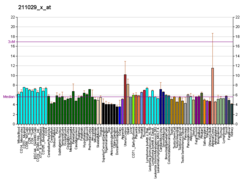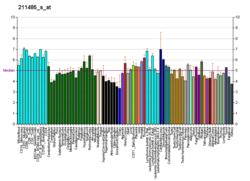FGF18
Fibroblast growth factor 18 is a protein that in humans is encoded by the FGF18 gene.[5][6][7]
The protein encoded by this gene is a member of the fibroblast growth factor (FGF) family. FGF family members possess broad mitogenic and cell survival activities, and are involved in a variety of biological processes, including embryonic development, cell growth, morphogenesis, tissue repair, tumor growth, and invasion. It has been shown in vitro that this protein is able to induce in PC12 cells. FGF18 signals through fibroblast growth factor receptor FGFR3 to promote chondrogenesis[8] and has been shown to cause thickening of cartilage in a murine model of osteoarthritis,[9] and the recombinant version of it (sprifermin) is in clinical trial as a potential treatment for osteoarthritis.[10] Studies of the similar proteins in mouse and chick suggested that this protein is a pleiotropic growth factor that stimulates proliferation in a number of tissues, most notably the liver and small intestine. Knockout studies of the similar gene in mice implied the role of this protein in regulating proliferation and differentiation of midline cerebellar structures.[7]
References[]
- ^ a b c GRCh38: Ensembl release 89: ENSG00000156427 - Ensembl, May 2017
- ^ a b c GRCm38: Ensembl release 89: ENSMUSG00000057967 - Ensembl, May 2017
- ^ "Human PubMed Reference:". National Center for Biotechnology Information, U.S. National Library of Medicine.
- ^ "Mouse PubMed Reference:". National Center for Biotechnology Information, U.S. National Library of Medicine.
- ^ Ohbayashi N, Hoshikawa M, Kimura S, Yamasaki M, Fukui S, Itoh N (Aug 1998). "Structure and expression of the mRNA encoding a novel fibroblast growth factor, FGF-18". J Biol Chem. 273 (29): 18161–4. doi:10.1074/jbc.273.29.18161. PMID 9660775.
- ^ Hu MC, Qiu WR, Wang YP, Hill D, Ring BD, Scully S, Bolon B, DeRose M, Luethy R, Simonet WS, Arakawa T, Danilenko DM (Nov 1998). "FGF-18, a Novel Member of the Fibroblast Growth Factor Family, Stimulates Hepatic and Intestinal Proliferation". Mol Cell Biol. 18 (10): 6063–74. doi:10.1128/MCB.18.10.6063. PMC 109192. PMID 9742123.
- ^ a b "Entrez Gene: FGF18 fibroblast growth factor 18".
- ^ Davidson, D.; Blanc, A.; Filion, D.; Wang, H.; Plut, P.; Pfeffer, G.; Buschmann, M. D.; Henderson, J. E. (2005). "Fibroblast Growth Factor (FGF) 18 Signals through FGF Receptor 3 to Promote Chondrogenesis". Journal of Biological Chemistry. 280 (21): 20509–20515. doi:10.1074/jbc.M410148200. PMID 15781473.
- ^ Moore, E.; Bendele, A.; Thompson, D.; Littau, A.; Waggie, K.; Reardon, B.; Ellsworth, J. (2005). "Fibroblast growth factor-18 stimulates chondrogenesis and cartilage repair in a rat model of injury-induced osteoarthritis". Osteoarthritis and Cartilage. 13 (7): 623–631. doi:10.1016/j.joca.2005.03.003. PMID 15896984.
- ^ Merck Announces Collaboration With Nordic Bioscience for Sprifermin in Osteoarthritis of the Knee, retrieved 2013-04-02
Further reading[]
- Haque T, Nakada S, Hamdy RC (2007). "A review of FGF18: Its expression, signaling pathways and possible functions during embryogenesis and post-natal development". Histol. Histopathol. 22 (1): 97–105. PMID 17128416.
- Hu MC, Wang YP, Qiu WR (1999). "Human fibroblast growth factor-18 stimulates fibroblast cell proliferation and is mapped to chromosome 14p11". Oncogene. 18 (16): 2635–42. doi:10.1038/sj.onc.1202616. PMID 10353607.
- Xu J, Liu Z, Ornitz DM (2000). "Temporal and spatial gradients of Fgf8 and Fgf17 regulate proliferation and differentiation of midline cerebellar structures". Development. 127 (9): 1833–43. doi:10.1242/dev.127.9.1833. PMID 10751172.
- Hartley JL, Temple GF, Brasch MA (2001). "DNA Cloning Using In Vitro Site-Specific Recombination". Genome Res. 10 (11): 1788–95. doi:10.1101/gr.143000. PMC 310948. PMID 11076863.
- Whitmore TE, Maurer MF, Sexson S, et al. (2001). "Assignment of fibroblast growth factor 18 (FGF18) to human chromosome 5q34 by use of radiation hybrid mapping and fluorescence in situ hybridization". Cytogenet. Cell Genet. 90 (3–4): 231–3. doi:10.1159/000056775. PMID 11124520. S2CID 84820296.
- Simpson JC, Wellenreuther R, Poustka A, et al. (2001). "Systematic subcellular localization of novel proteins identified by large-scale cDNA sequencing". EMBO Rep. 1 (3): 287–92. doi:10.1093/embo-reports/kvd058. PMC 1083732. PMID 11256614.
- Strausberg RL, Feingold EA, Grouse LH, et al. (2003). "Generation and initial analysis of more than 15,000 full-length human and mouse cDNA sequences". Proc. Natl. Acad. Sci. U.S.A. 99 (26): 16899–903. doi:10.1073/pnas.242603899. PMC 139241. PMID 12477932.
- Clark HF, Gurney AL, Abaya E, et al. (2003). "The Secreted Protein Discovery Initiative (SPDI), a Large-Scale Effort to Identify Novel Human Secreted and Transmembrane Proteins: A Bioinformatics Assessment". Genome Res. 13 (10): 2265–70. doi:10.1101/gr.1293003. PMC 403697. PMID 12975309.
- Popovici C, Conchonaud F, Birnbaum D, Roubin R (2004). "Functional phylogeny relates LET-756 to fibroblast growth factor 9". J. Biol. Chem. 279 (38): 40146–52. doi:10.1074/jbc.M405795200. PMID 15199049.
- Gerhard DS, Wagner L, Feingold EA, et al. (2004). "The Status, Quality, and Expansion of the NIH Full-Length cDNA Project: The Mammalian Gene Collection (MGC)". Genome Res. 14 (10B): 2121–7. doi:10.1101/gr.2596504. PMC 528928. PMID 15489334.
- Wiemann S, Arlt D, Huber W, et al. (2004). "From ORFeome to Biology: A Functional Genomics Pipeline". Genome Res. 14 (10B): 2136–44. doi:10.1101/gr.2576704. PMC 528930. PMID 15489336.
- Cormier S, Leroy C, Delezoide AL, Silve C (2005). "Expression of fibroblast growth factors 18 and 23 during human embryonic and fetal development". Gene Expr. Patterns. 5 (4): 569–73. doi:10.1016/j.modgep.2004.10.008. PMID 15749088.
- Antoine M, Wirz W, Tag CG, et al. (2005). "Expression pattern of fibroblast growth factors (FGFs), their receptors and antagonists in primary endothelial cells and vascular smooth muscle cells". Growth Factors. 23 (2): 87–95. doi:10.1080/08977190500096004. PMID 16019430. S2CID 27380246.
- Mehrle A, Rosenfelder H, Schupp I, et al. (2006). "The LIFEdb database in 2006". Nucleic Acids Res. 34 (Database issue): D415–8. doi:10.1093/nar/gkj139. PMC 1347501. PMID 16381901.
- Antoine M, Wirz W, Tag CG, et al. (2006). "Fibroblast growth factor 16 and 18 are expressed in human cardiovascular tissues and induce on endothelial cells migration but not proliferation". Biochem. Biophys. Res. Commun. 346 (1): 224–33. doi:10.1016/j.bbrc.2006.05.105. PMID 16756958.
- Riley BM, Mansilla MA, Ma J, et al. (2007). "Impaired FGF signaling contributes to cleft lip and palate". Proc. Natl. Acad. Sci. U.S.A. 104 (11): 4512–7. Bibcode:2007PNAS..104.4512R. doi:10.1073/pnas.0607956104. PMC 1810508. PMID 17360555.
External links[]
- Genes on human chromosome 5






